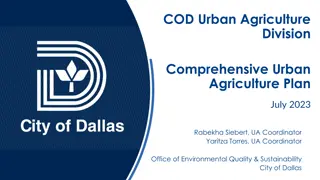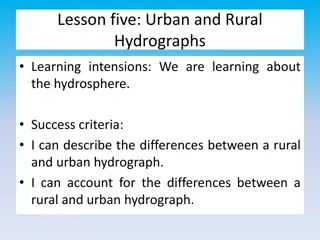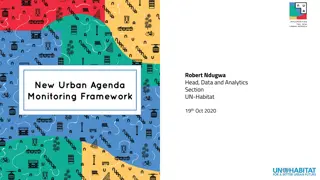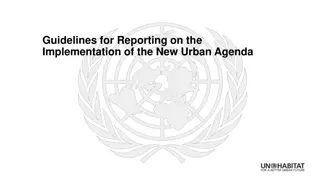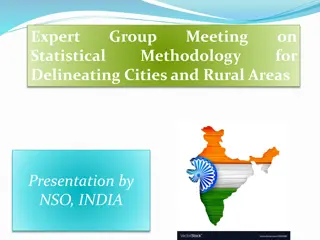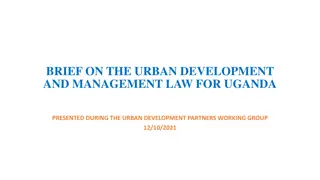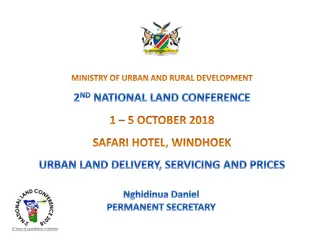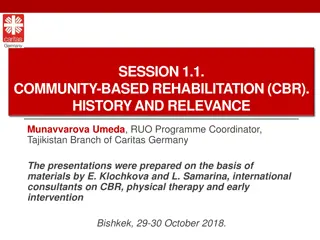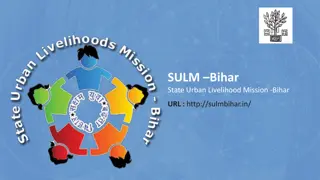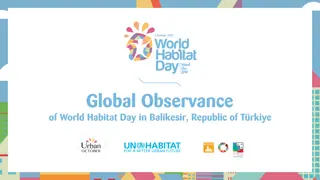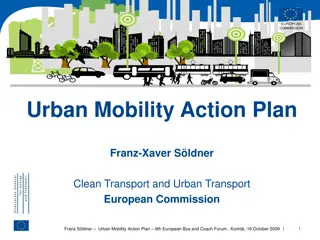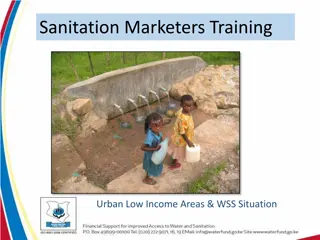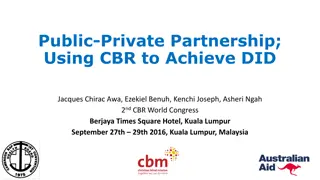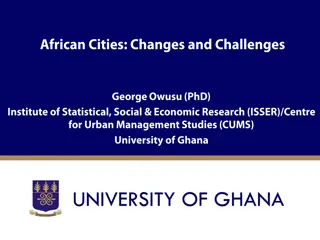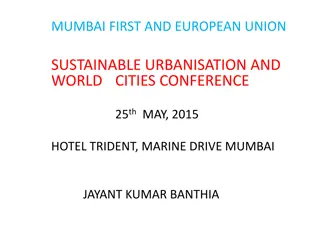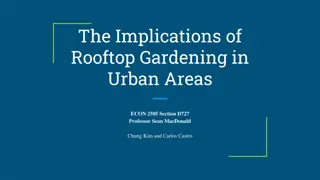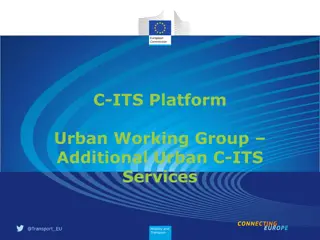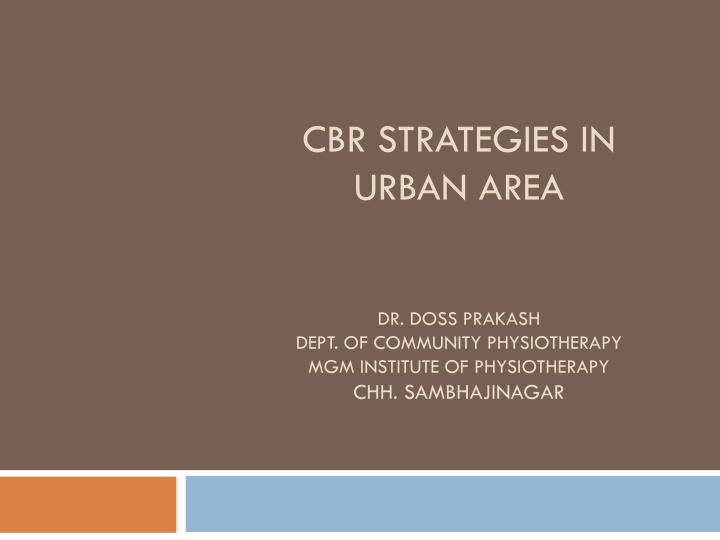
Challenges Faced by Urban Poor and Slum Dwellers
Urban areas are experiencing an increase in disorderly slums due to rural-urban migration and displacement of poor populations. These areas suffer from high population density, lack of proper housing, limited access to services, and social issues like ethnic conflicts and lack of education. Living in slums exposes individuals to health risks, violence, and social problems, making survival a daily struggle.
Download Presentation

Please find below an Image/Link to download the presentation.
The content on the website is provided AS IS for your information and personal use only. It may not be sold, licensed, or shared on other websites without obtaining consent from the author. If you encounter any issues during the download, it is possible that the publisher has removed the file from their server.
You are allowed to download the files provided on this website for personal or commercial use, subject to the condition that they are used lawfully. All files are the property of their respective owners.
The content on the website is provided AS IS for your information and personal use only. It may not be sold, licensed, or shared on other websites without obtaining consent from the author.
E N D
Presentation Transcript
CBR STRATEGIES IN URBAN AREA DR. DOSS PRAKASH DEPT. OF COMMUNITY PHYSIOTHERAPY MGM INSTITUTE OF PHYSIOTHERAPY CHH. SAMBHAJINAGAR
The urban poor and slum dwellers Past decades have seen a gradual increase in disorderly and informally occupied urban areas, a result of rural urban migration and displacement of poor population groups in search of livelihoods and survival. These urban areas are known as slums, and they are characterized by the following factors:
High population density and lack of proper housing: Large numbers of persons are forced to live together in small spaces. For a majority of poor persons living there, the living spaces may be precarious structures made of mud, tin sheets or plastic, etc. Changing dimensions and security: Some of these areas may be relatively new and constantly threatened by bulldozers. Others may be of a much longer duration, even decades, constantly enlarging with the arrival of new persons. Occasionally the civic authorities may even legalize some areas. Poverty: Though the majority of the inhabitants are poor, unemployed or employed as wage earners or labourers in informal sectors, some persons may be relatively better off in certain longstanding areas.
Services: Many of these areas do not have access to public services such as electricity, roads, hygienic services, drinking water, health care, education, etc. Mobility: Some inhabitants, especially in long-standing areas, may be relatively stable while others are more mobile, forced to search for alternative places or to come to the urban areas for seasonal work. Persons living in long- standing areas may have been born and raised there. Ethnic, religious and linguistic differences: In some of these areas, the inhabitants may belong to different ethnic, religious or linguistic groups characterized by occasional conflicts.
Many need to cope with alien surroundings, different languages, cultures, ethnic origins and religions, etc. For survival, whole families including children may need to work or older children may need to take care of the younger siblings. Even when families realize the importance of education, their children may not have access to education because of the shortage of schools in the neighbourhood, because of teachers attitudes or because of bureaucratic difficulties such as the lack of children s birth certificates. Other problems resulting from this situation include violence, drug and substance abuse, prostitution, child begger etc. Lack of hygiene and basic health services may lead to higher risks of infections, ill health and disabilities with high rates of morbidity and mortality. Violence, especially towards vulnerable groups such as persons with disability, can be a serious problem.
Given all these conditions, it is difficult to visualize a community among the urban poor and slum dwellers. However, family members, friends, neighbours and concerned persons in the low-income and slum areas can constitute a first level of community . In addition, in long-standing slum areas there may be persons who are Recognized leaders because of their political, civic or religious role. Organizations or informal groups of women and/or youths in the slums and urban poor
Initiating CBR strategies Concerned parents or local grass-roots groups - initiate a CBR programme Intervention of external facilitating agencies, which could be governmental authorities or local NGO Before any such programme starts, the communities need to have some familiarity with and confidence in the persons belonging to the initiating agencies. At the same time it is essential for the initiating agencies to have a good knowledge about the people and their main problems. Thus, a CBR programme should be seen as a slow and gradual process.
In addition, before any CBR activity starts, it is necessary to define the target area and to identify key persons and local institutions and organizations already present in the area. It is important to discuss and define the activities needed with community members and community leaders. It may not be very easy to organize a meeting with community members, especially the family members of disabled persons and other vulnerable groups, to explain the ideas and to set in motion the first discussions, especially if the persons promoting the CBR programme are perceived as outsiders.
One possible initial step is to introduce a basic service, such as a nursery school or basic health care, or to strengthen an existing service, which would give the community a chance to interact with the initiating agency and to build familiarity and confidence. It would also allow the agency staff to learn about and discuss community needs, priorities and problems. Existing local initiatives started by concerned parents and groups can be very important and all those concerned can be involved in discussions and planning from the outset.
The identification and involvement of community leaders including influential persons, political and/or religious leaders become critical in this initial phase. For example, it is helpful to involve and inform local authorities such as civic authorities or police, etc. Both these activities may be difficult and require persistent and repeated efforts.
Understanding the needs Carrying out a survey to identify disabled persons and other vulnerable population groups is helpful in defining the magnitude of the problems and for promoting discussions with local communities activities and their implementation methodologies. such surveys expectations and lead to disillusionment even before the start of activities. Poor and slum communities may have past experience suspicious and uncooperative. about priority However, may build up unrealistic of surveys, making them
Empowerment and community participation Empowerment means that disabled persons and other target groups along with their family members and concerned persons in the community are aware of their rights and their collective strengths, have the necessary skills and resources to ensure access to existing services and facilities, and can take advocacy action to demand equal opportunities. Enabling empowerment is closely linked tocommunity participation and ownership of the different aspects of the CBR programme.
For example, countries have laws concerning access to transport and allowances for disabled persons about which persons living in urban low-income and slum areas may not be aware. A CBR programme in such a situation can provide information about these laws. Persons having this information may not know exactly how to benefit from such laws and how to fill in the forms to obtain the required certificates, identity cards and other documents; CBR programmes can provide practical skills and help in this aspect. Persons having both the information and the skills may still be unable to obtain the required documents because of a lack of financial resources necessary for the request, and the CBR programme can help by promoting savings and credit funds to provide loans in these situations. Initially such information and skills may depend entirely on the staff of the initiating agencies, but persons from local communities can eventually be trained to take on this role.
Promoting DPOs CBR programmes can help in creating links between the communities and existing DPOs in the cities. They can also help in bringing together persons with disabilities, family members and other concerned persons in the formation of such local organizations. Through support for management and leadership training such organizations play a vital role in the CBR programme, for example, in awareness and information activities, as well as in running cooperatives and savings and credit funds.
CBR and community committees Role of public authorities Role of CBR personnel Initially the promotion of CBR activities in low-income and slum areas may require paid staff to work with the community. Such staff could ideally be from the target communities themselves; however, it may not be possible to find persons with the required training. The selection and training of paid staff to work in low-income and slum areas require special attention. The training must emphasize their role as facilitators and the overall goal of community takeover and ownership of the activities.
Activities Health & Rehabilitation Education Work & income generation

